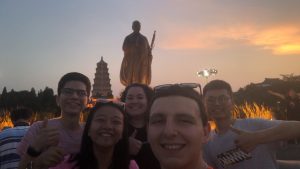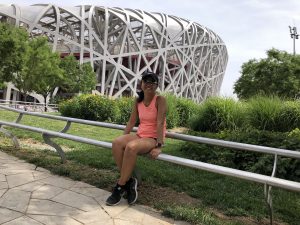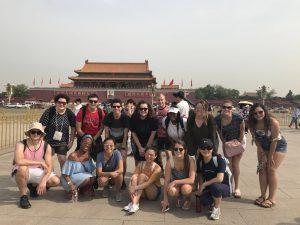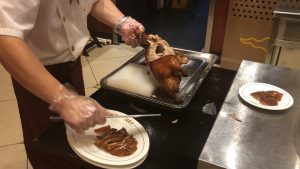This blog is to share important aspects gained from my experience studying abroad in China. I will only highlight certain aspects and experiences from this trip. I spent 14 days in China; 10 days in Xi’an and 4 days in Beijing. The trip was from May 21st-June 5th. This was a faculty led study abroad trip. It is intended for International Business majors. I am majoring in Healthcare Administration and minoring in Business and Insurance. I am grateful for Dr. Zhang for allowing me to go on the trip. I took four years of Mandarin in high school. This was a great opportunity to really apply everything I learned and it came in handy. While in China we took Chinese cultural classes, visited historical places, and ate lots of food. I was able to do so much in such a short amount of days. I hope by the end of this blog you gain a little history of China, get a sense of what I experienced in two weeks and possibly be inclined to visit China one day.
10 days in Xi’an…
Shaangxi Normal University

We stayed at a hotel on campus at Shaangxi Normal University. I enjoyed walking around the campus in my free time. The campus had a lot of trees and shade, which protects everyone from the sun. There was a convenient store right by our hotel in walking distance. This store came in handy if anyone forgot something at home. Right outside the campus gate was a street full of stores, a doctors office, and many restaurants. There was aways something for us to do in our free time. I really enjoyed the area and felt safe staying at the University.
 This photo was taken at the opening ceremony. I really appreciate all the hospitality and accommodations the directors of the program gave us.
This photo was taken at the opening ceremony. I really appreciate all the hospitality and accommodations the directors of the program gave us.

This is a photo of the library on campus. I really liked looking at the architecture and design. It was a very traditional Chinese style.

This is a picture of the cafeteria on campus. It was two floors and with many food options. The days are very structured for Chinese students. All the students are in class at the same time and afterwards eat all together. They eat quickly so they have time to nap before their next class. It was a unique opportunity to experience a college students daily life routine.
Chinese Language Partners:
Our language partners played a major role in our experience from day one. I am so grateful for all of the language partners who helped make Xi’an feel like home. The 15 of us were assigned to a language partner. They helped translate, took us shopping, helped us bargin, took us to get food, and showed us around. I am especially grateful for Serena and Chen. We became good friends in such a short time. I already miss them. Nick and I gave them T-shirts from BGSU on our last night together. They were so happy and grateful for such a small gesture. In return, the bottom left photo is the gift we received from them. I will forever be grateful for the two of them and all the support they gave us. The bottom right photo is a group of us sitting outside the gate of the University.

One night Chen took us to see the Giant Wild Goose Pagoda. The Wild Goose Pagoda is an ancient temple and a holy place for the Buddhists. It was a half hour walk from campus. There was a lot of scenery to see along the walk. There was a park, statues, street dancers, and live music. When the sun went down we stayed and watched the musical fountain light show.
Chinese Cultural Classes:

While staying at the University we took many cultural classes. We took Tai Chi, calligraphy, painting, paper cutting, tea ceremony, and learned basic Mandarin. It takes lots of practice and discipline to become a master at the cultural classes, but it was a good way for us to gain some knowledge.
 The traditional tea ceremony class was my favorite cultural class. I did not realize how much preparation and symbolism goes into drinking tea. The top photo is a traditional tea table. Any water that spills onto the table will empty into a bucket. The tables are designed strategically and have a unique style. During the class, we had the chance to taste four different kinds of tea. I did not know that the tea can taste different based on who prepares the tea. My personal favorite was the black tea because it almost tasted like honey. One aspect of the tea ceremony that I found intriguing is that the teacher had her degree in tea making. She was a master at making tea. This goes to show how important tea is to Chinese culture and the complexity of the art.
The traditional tea ceremony class was my favorite cultural class. I did not realize how much preparation and symbolism goes into drinking tea. The top photo is a traditional tea table. Any water that spills onto the table will empty into a bucket. The tables are designed strategically and have a unique style. During the class, we had the chance to taste four different kinds of tea. I did not know that the tea can taste different based on who prepares the tea. My personal favorite was the black tea because it almost tasted like honey. One aspect of the tea ceremony that I found intriguing is that the teacher had her degree in tea making. She was a master at making tea. This goes to show how important tea is to Chinese culture and the complexity of the art.
Yuanjiacun Village:

One of the trips we took was to the Yuanjia Village. The village was located a little over an hour outside of the city. This village was owned and operated by one family and had around 60 households living there. The village generates around 3 billion Yuan a year ($5M). Each household has one specialization, and they only make and sell what they are good at. Dr. Zhang, explained that the village is centrally planned and controlled. All the money from each store goes into a central fund. The village has won lots of awards and has become the model village for all other villages. This was a beneficial trip to learn and see a different way of doing business.
Terracotta Army:
This photo is of the Terracotta Warriors. Prior to coming to China I knew about this attraction, but not the history behind the warriors. The Terracotta Warriors are from the Qin Shi Huang Dynasty, the first dynasty of China. The clay figures were made to protect Emperor Qin in his afterlife. When we went into the gift store, the farmer who found the warriors was sitting at a table signing autographs. He discovered the army while digging for a well in 1974. There are 8,000 clay figures in total. The picture I took is not of all of the warriors. The detail and uniqueness of each clay figure is astonishing. Also, the warriors originally had color but the oxygen and materials in the air discolored them. The rest are protected by the government to preserve the color until technology advances.
Silk Road:

This is a photo of me sitting at the exact starting point of the Silk Road. Xi’an used to be the capital of China, which is why the Silk Road originated here. Mary, our tour guide explained to us that China is shaped like a rooster and Xi’an is located at the heart of the rooster. This is why Xi’an was the capital and was a central point for trade.
The characters on the top half of the circle say “Chang An”, which was the original name of the city. The bottom characters are Xi’an, what it’s known as today. The Silk Road has a lot of history and is very important to international trade and business. In ancient times the Silk Road was used as a network of trade routes that connected the East and West. This helped shape modern day international trade and business.
Song of Everlasting Sorrow:
 Dr. Zhang took us to see “The Song of Everlasting Sorrow” written by Bai Juyi. The show was located outside the city in a hot spring and was was partly on water. It was all in Chinese but Dr. Zhang explained to us what it was about. The show was a spectacular dramatic interpretation of the poem. It a takes place during the Tang Dynasty, where the emperor falls in love with Lady Yang. He is so in love that the government wants Lady Yang to be killed because she is a distraction, so she is forced to kill herself. This leaves the emperor heartbroken and the poem ends with the two of them meeting again in his dreams. Many locals and tourists came to see the show. I am very fortunate to have seen the show live.
Dr. Zhang took us to see “The Song of Everlasting Sorrow” written by Bai Juyi. The show was located outside the city in a hot spring and was was partly on water. It was all in Chinese but Dr. Zhang explained to us what it was about. The show was a spectacular dramatic interpretation of the poem. It a takes place during the Tang Dynasty, where the emperor falls in love with Lady Yang. He is so in love that the government wants Lady Yang to be killed because she is a distraction, so she is forced to kill herself. This leaves the emperor heartbroken and the poem ends with the two of them meeting again in his dreams. Many locals and tourists came to see the show. I am very fortunate to have seen the show live.
Great Food:

I really enjoyed the food during my stay in China. All the meals were family style and served on a lazy susan. I have become very comfortable with using chopsticks. I also liked not having to order the food because Dr. Zhang or the tour guide would order for us. Sometimes the food was a little spicy, but there was always enough food and a variety to choose from. I was able to be adventurous when eating.
4 Days in Beijing…
We only spent 4 days in Beijing and did a lot of site seeing in a short time. Beijing is very big and a little overwhelming compared to Xi’an. We visited the Forbidden city, Tiananmen Square, different empirical gardens, the Birds Nest (08’ Olympic stadium), the Temple of Heaven, the Great Wall of China, and Summer Palace.
Birds Nest: 
Here is a photo of me sitting outside the Birds Nest. It got its name because of how it resembles a birds nest from the outside. This is where the 2008 summer Olympic ceremony was held. While being there I thought about how at one point people from all over the world stood where I was. I also learned that Beijing will be hosting the winter Olympics in 2022.
Tiananmen Square and Mausoleum of Mao Zedong:


Tiananmen Square is in the center of Beijing and was very big. It translates to “Gate of Heavenly Peace”. It reminds me of Washington D.C. The photo on the left is the Great Hall of the People which is like the U.S. White House. The monument in front of the Great Hall is the Monument to the Peoples Heroes. We did not have time to go inside any of the buildings because the tour guide said it would take all day to explore.
In the group photo above to the right, we are standing outside the Mausoleum of Mao Zedong. This is where chairman Mao stood in front of the people and declared China as the People’s Republic of China in 1949. This is also where Mao is laid to rest.
Forbidden City:


These two photos are of the Forbidden City. This place is featured in many movies and TV shows. It is named the Forbidden City because only the emperor had access everywhere inside the city. Government officials and imperial family only had limited access. The architecture was complex and strategically designed. For example, the rooftop being yellow or gold represented the emperor and power. Only emperors were allowed this color. Our tour guide, Summer, told us that one of the youngest emperors to live in the Forbidden City was Puyi. Puyi was only 3 years old when he entered the Forbidden City. The dynasty soon collapsed after Puyi.
Great Wall of China:

The Great Wall of China is one of the 7 Wonders of the World. The wall is not one long continuous wall like most people assume. It is broken into sections. The section behind us in the group photo is the part we climbed. It looked like a simple journey from the bottom but in reality it was very exhausting, but hiking up th e wall was worth the view.
e wall was worth the view.
This photo is of Ming, me, Dr. Zhang, Victoria, and Morgan (left to right). There is a saying in Chinese about climbing the wall. It is 不到长城非好汉 (bú dào Chángchéng fēi hǎohàn), which is translated to “He who has never been to the Great Wall is not a true man.” Our tour guide called us all heroes for climbing the wall.
Summer Palace:


This was one of my favorite gardens we visited while in China. The Summer Palace is the largest imperial garden existing in China. We climbed to the top of the palace. The view from above was astonishing. When I looked to my left I saw skyline of Beijing, but to my right was the mountains and Great Wall. I loved being that high up and seeing everything. After climbing we took a boat across the water. I would love to go back to the Summer Palace.
Beijing (Peking) Duck

Beijing is known for preparing the best roasted duck. This is a must try dish while in Beijing. We went to a restaurant famous for the Beijing duck and got to try it. When eating the duck, you wrapped it into a tortilla shell with sauce and other veggies. I was not a huge fan of the duck, even though it tasted similar to chicken.
Closing Remarks…
KFC Project:

I chose to add this into the blog because the project was a major aspect of this trip, amongst all the fun we had. While in China, 3 students were assigned to do a comparison project on KFC. This was to help us understand how business globalization works and the business strategies used when entering a foreign market. These photos show my group members and I interviewing children who were eating at KFC. Talking to the locals and asking them questions really helped us obtain valid data on the differences. We took our language partner Chen with us to help translate. Something I did not realize prior to the project, is that KFC is very popular in China. This popularity is due to the marketing strategies used in China. We learned how important it is for businesses to adapt to the locals but still being able to keep certain things standardized. For example, Colonel Sanders is well known in China. We presented a PowerPoint on our findings at the closing ceremony. When we get back to BGSU, we will also be presenting our project. I am looking forward to our next presentation.
Xie Xie (Thank You)
Thank you for taking the time to read this blog post. I want to thank my parents for allowing and supporting me on this journey. I also appreciate all the hard work Dr. Zhang, the teachers and director at Shaangxi University have put into this program. I cannot put into words how grateful I am to have the opportunity to go back to where I was adopted from. I am leaving with so much knowledge about my culture and much more. I cannot wait to go back one day.




